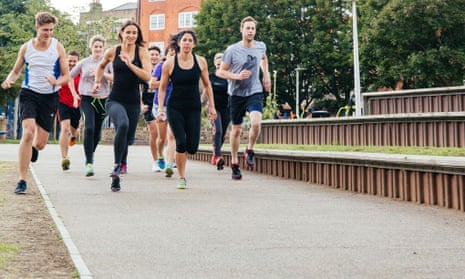The clock ticks to 5pm and, officially, your working day is over. What’s your next move? Are you frantically cramming for tomorrow’s big presentation, or rounding up your team for your weekly exercise class?
As an entrepreneur, you might think of the former as more beneficial to business – every minute of the day can be invested in bettering your company and there is always a new task to tackle. But failing to take time out for exercise and relaxation puts you and your team at risk of high stress levels, which in turn affects productivity. In the UK, 11.3 million days of work were lost in 2013-2014 due to stress, depression or anxiety – an average of 23 days per person.
Debbie Williamson, co-founder of online furniture store Swoon Editions, explains that for a small operation like hers, 23 days equates to 10% of the working year. “If we didn’t create an environment in which our employees prioritise their wellbeing and look out for each other during busy times, we would need to compensate by increasing our workforce, with no added value for the customer” she says.
Exercise and a balanced diet are proven panaceas to everyday strains. The better your team are looking after themselves, the fewer working hours will be lost.
So how can you encourage your staff to favour exercise, or a healthy lunch eaten away from their desk, over an extra hour of work? Some small business owners find that offering free fitness initiatives is effective. Williamson is a fitness enthusiast and was keen to share her pastime with her staff, so she brought in the “Swoon Sweater” – a free weekly fitness session in a nearby park after work. The participants are drilled by a personal trainer with resistance exercises like push-ups and squats, and cardio, including on-the-spot jumps, sprints, and step aerobics.
Williamson’s fitness drive has been a hit, with most of the firm’s 58 staff getting involved on a regular basis. Alongside the Swoon Sweater, all the company’s employees are offered free gym membership. This is a substantial commitment for a small company – it costs Swoon £10,000 per year – but Williamson thinks it’s a good investment. “It offers the team opportunities to mix outside the workplace, so the engineering team gets to hang out with the care team, for example, and this contributes significantly to morale. I would definitely recommend other businesses consider a similar initiative.”
Psychotherapist Robert Stewart, who works with businesses on staff wellbeing, says that getting active could lead to a more productive workforce: “Exercise helps with the production of endorphins and serotonin – our pain relief and happy hormones. Both of these hormones assist in the regulation of metabolism, sleep, concentration and motivation.”
Meanwhile, a recent study published in the British Journal of Sports Medicine found that regular, aerobic exercise can boost the size of the hippocampus, the area of the brain involved in verbal memory, learning and emotions.
While initiatives such as Swoon’s are designed to support healthy habits, there’s a fine line between encouraging staff wellbeing and adding pressure to what is already expected of them at work. Julie Creffield, founder of Too Fat to Run, consultant for the British Sports Council and ambassador for This Girl Can, a nationwide campaign encouraging women and girls to exercise, says giving employees some freedom is the best approach.
“Sitting at a desk all day can leave you feeling fatigued and your work suffers,” says Creffield. “It’s a problem if a member of staff can’t just say they’re going for a break, or for a walk, and instead, has to wait until lunchtime. If you trust staff [to manage their time], you’ll have a more productive workforce.”
If your team is less health-conscious than Swoon’s, then adding healthy options to their current routine could be a good starting point. Helena Mann, operations manager at Crunch Accounting, took this approach with her colleagues. “They’d be sitting at their desks eating a big sandwich [for breakfast] or they’d go and grab something from the local KFC. We wanted to try something to get people away from their desks.”

So Crunch introduced free breakfasts, offering options like muesli and granary toast, and created areas with sofas and tables to encourage people to take a break and socialise. Staff can also enroll in the company’s cycle to work and gym discounts schemes. Mann says providing breakfast costs Crunch about £200 per month, but the benefit it brings to the company outweighs the cost. “It gives the start of a day a more relaxed feel – rather than checking your emails while trying to spoon cereal into your mouth, you’re sat away from your desk having a nice chat with your colleagues. I think starting the day like this does increase productivity.”
Stewart says that managers shouldn’t aim to completely eradicate stress in their staff, as it can be a motivator, but to help them maintain their “stress sweet spot” – the level that gives them optimum productivity. Exercise can help you to either de-stress or re-energise, something that more employers are beginning to recognise. Stewart points to the public sector scheme in Turkey where staff are allowed to come in to work an hour later, provided they use that time for exercise.
One way to measure activity levels is with wearable technology. Jane Michell, founder of the fitness and weight loss programme Jane Plan, has given out Fitbits, fitness trackers worn on the wrist, to all her staff. Michell says: “I know the team like to stay active – and we’re all very sedentary at our desks most of the day – so I thought it would be a great idea if we all got them.”
Michell’s team, all women and mostly under 30, have taken to the perk with enthusiasm, and Michell has also instigated a walk to work initiative. “No matter how far away we lived, we all walked a part of the journey – one of the team even walked from Stratford to Liverpool Street, which is 7.4 miles,” says Michell. And she’s seen a positive effect: “I think on the whole our level of wellbeing is good, but the Fitbits have helped us improve on it.”
While activity trackers may work in teams of a similar fitness level, for those less used to exercise the devices could add to the pressures of workplace performance. But Stewart says they could have the opposite effect, too: “Every time we view a number or goal [on an activity tracker], we activate the incentive driven part of our brain and initiate dopamine release.”
There are also legal implications in giving them out for staff use. Hugh Hitchcock, a director at law firm DJM Solicitors, says businesses must clearly state in their data protection policy if, and how, the data collected by the trackers will be stored and used.
Implementing wellbeing initiatives in your workplace, and doing it effectively, is about balance and tailoring activities to the interests of your staff. Provided you get this right, you can improve productivity levels and staff attitudes towards your business – in a 2013 survey by Mind, 60% of workers said they’d feel more motivated if their employer took action to support their mental wellbeing.
Creffield sums up the best approach to encouraging wellness in the workplace: letting the individual choose for themselves. “Staff should talk to their employers about how important health is to them – encourage them to open up conversations.”
Sign up to become a member of the Guardian Small Business Network here for more advice, insight and best practice direct to your inbox.

Comments (…)
Sign in or create your Guardian account to join the discussion